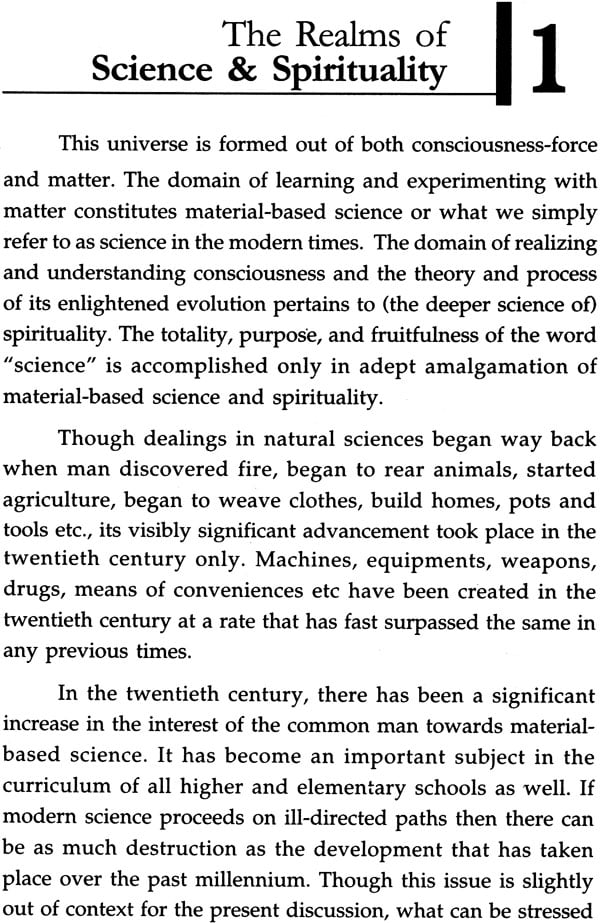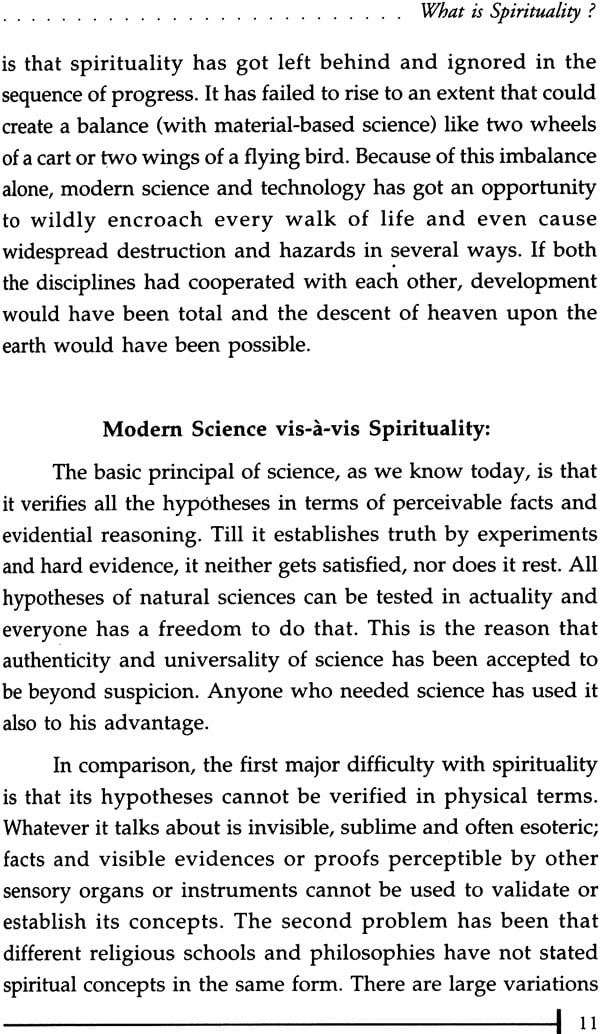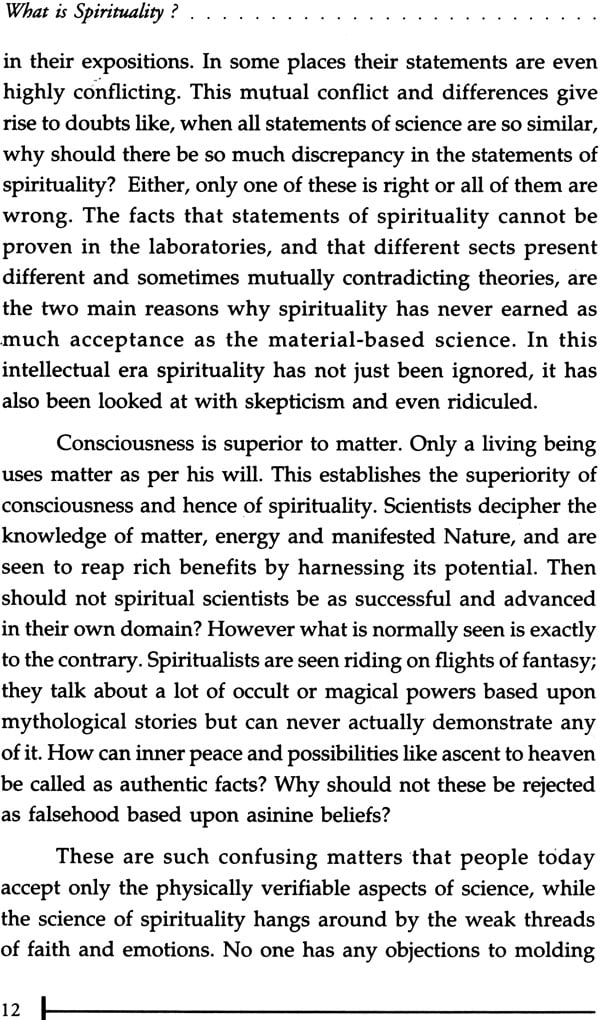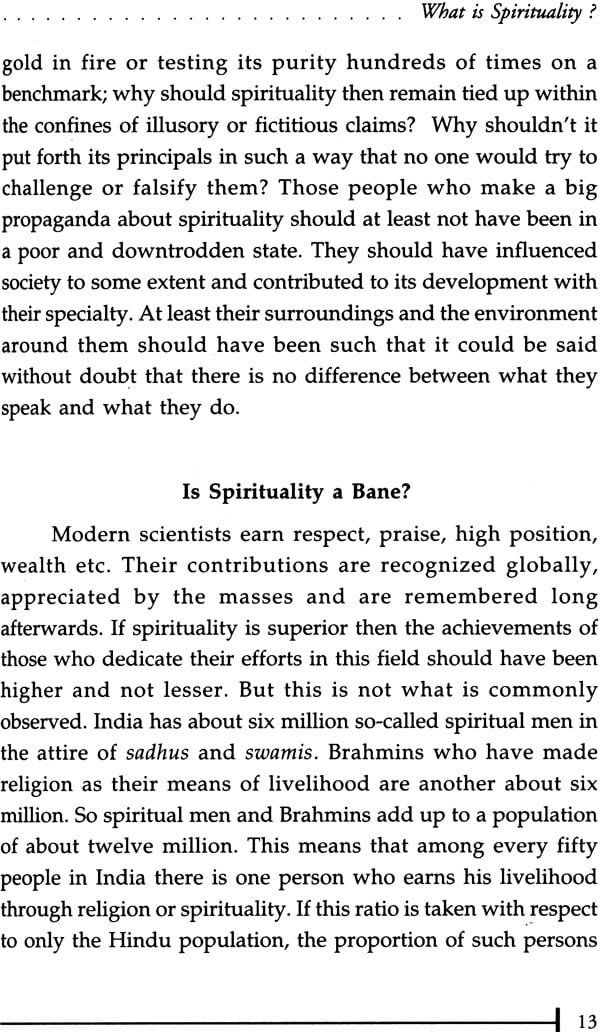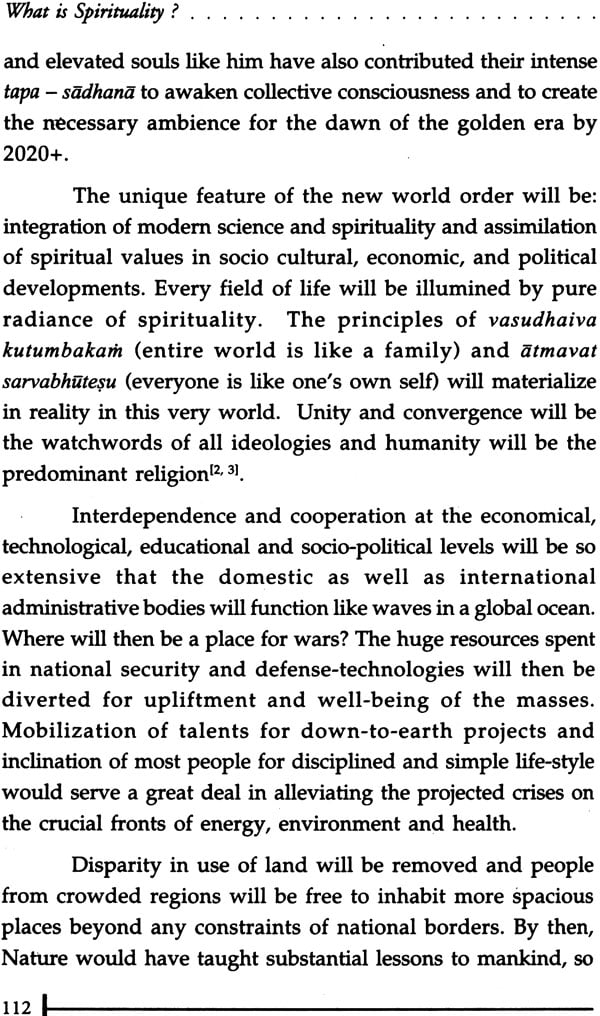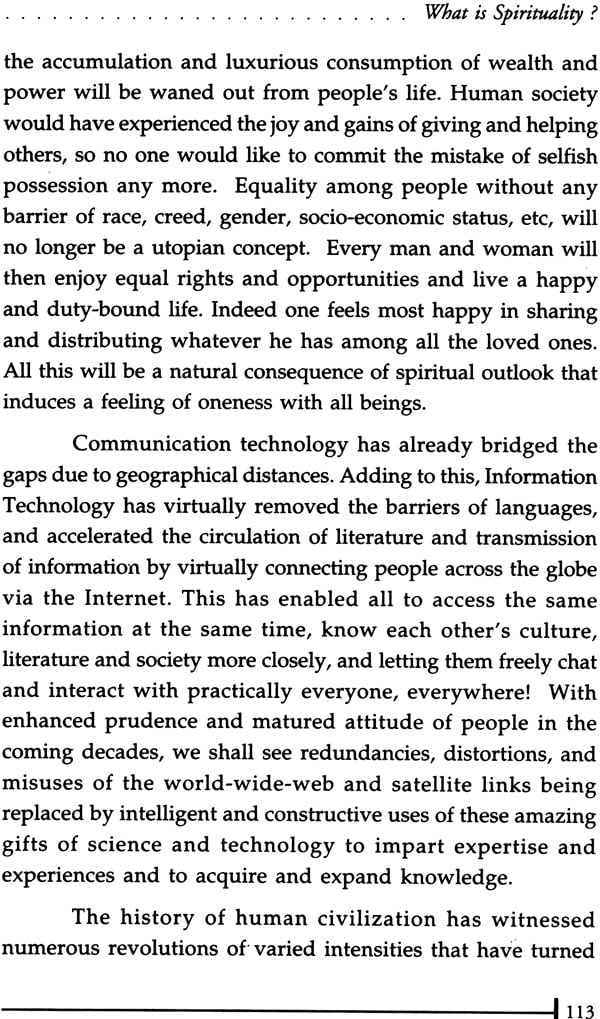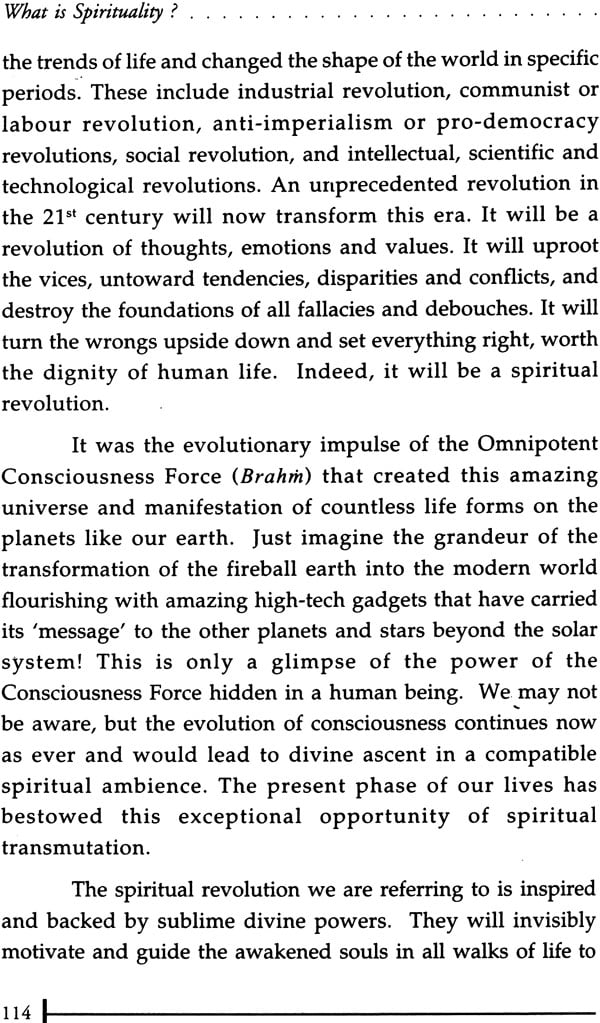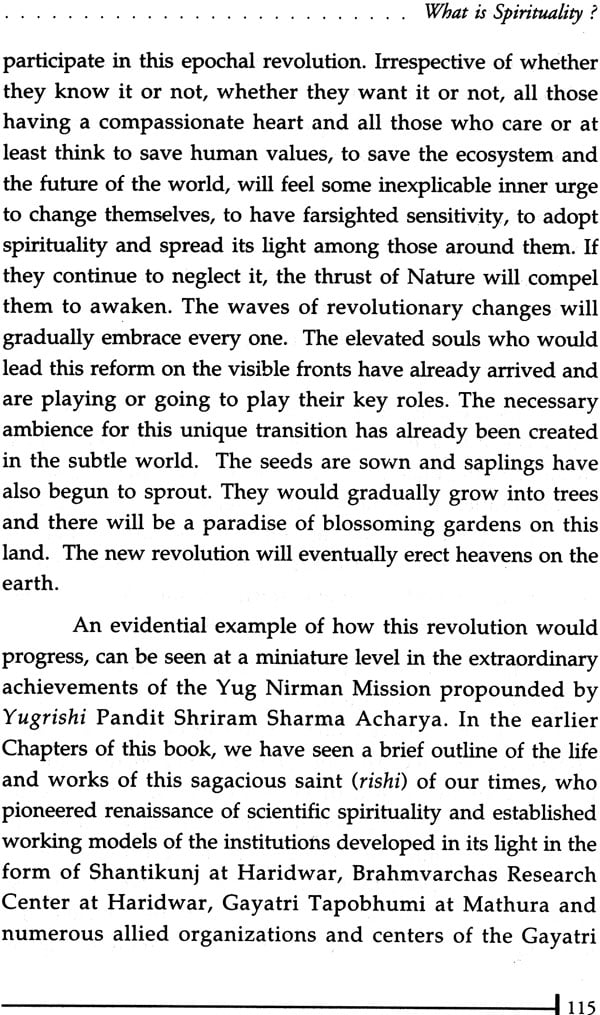
What Is Spirituality?
Book Specification
| Item Code: | NAD876 |
| Author: | Brahmavarches |
| Publisher: | Shri Vedmata Gayatri Trust, Shantikunj, Haridwar |
| Language: | English |
| Edition: | 2010 |
| ISBN: | 8182550254 |
| Pages: | 118 |
| Cover: | Paperback |
| Other Details | 8.5 inch X 5.5 inch |
| Weight | 130 gm |
Book Description
Spirituality deals with enlightening one's thoughts, emotions and intrinsic tendencies. In simple terms it is the most evolved and comprehensive science of psychological, sociological and moral development, and ultimate progress. It brightens the intellect together with inculcation of sensitivity towards fellow beings and towards the grace of Nature. There is no place for superstitions, fantasy or escapism in a truly spiritual life. Spiritual progress in no way blocks scientific and materialistic progress. In fact, it gives altruistic touch and prudent directions to both so that progress will not be focused only towards increase in luxurious comforts and worldly profits; it will not enrich and empower only some privileged ones. Scientific and materialistic progress guided by spirituality would lead to a holistic growth whose benefits would reach out to the whole of humanity and which will not result in any counter-effects in future. Spirituality can and should be adopted on every front of life for elevating happiness and illuminating the future.
Shriram Sharma Acharya, a pioneer of spiritual renaissance was born on 20th September 1911, in Anwalkheda, Agra District. He scrupulously carried out the biddings of his figteen a great Himalyan Yogi, when he was fifteen years of ago.
He took part in the struggle for independence as a volunteer, went to jail a number of times and embarked upon the task of social and moral upliftment through spiritual means in 1935 with the blessings of Mahatma Gandhi.
A sage, a visionary and a reformer, the Acharya inintiated 100 points Yug Nirman Yojna, lived a disciplined life of devout austerity, visited the Himalayas several times and attained spiritual eminence.
The Gayatri Pariwar fraternity; Shantikunj Ashram- an academy for moral and spiritual awakening; Brahmavarchas Research Institute-which strives to synthesize science center (Shakti-peeths) are his greatest contributions to the modern world.
He translated the entire Vedic Vangmaya and accopmplished a feat of writing more than 3000 books on all aspects of life.
The Acharya, Great devotee of Gayatri lived an ideal life for 80 years and voluntarily shed his physical sheath on Gayatri Jayanti, 2nd June 1990.
The domains of spiritual knowledge and practices are neither confined to abstract philosophical deliberations of some scholars, nor to some mythological narrations or rhetoric anecdotes of the lives of divine incarnations that might attract or engross the minds of devotees. Intellectually inspiring discourses and discussions, or devotional songs and stories may serve the purpose of introducing or attracting the minds of the listeners towards some spiritual teachings. But this alone is not sufficient for spiritual progress. Same is true of the religious rituals like worship. These practices would be nothing more than some different kinds (may be ‘holy kinds’, though) of entertainment unless one attempts to adopt the underlying teachings in one’s conduct. Devotion is not some kind of hallucination or sentimental excitement. It is a process of inner linkage and eventual unification with the object of devotion. It demands surrender of ego, change of attitude, and control with positive orientation of ambitions of the devotee to match with the noble qualities of the deity.
The rituals of worship use a visible symbol of greatness, of elevated virtues e.g. a holy picture or idol of a manifestation of God. Looking at this symbol helps in easy attention of mind. Lighting lamps and fragrant sticks in front of the deity, offering sacred water (oblation), flowers, clothes, sweets, etc, singing devotional songs, praying before it, further help positive conditioning of the mind. But this alone is not sufficient. Often it is found that ‘religious minded’ people regard completing of some rituals (puja-patha), visiting a shrine and chanting prayers and doing some worship there on some auspicious day, taking a dip into the holy rivers and ponds, etc, as the end of fulfilling their religious duties or spiritual efforts.
Not only that, people often put a list of their demands before the deity and ‘promise’ doing some special kind of worship, distributing sweets of some special kind in large quantity, donating gold or money in the shrine in return. It is like a cheap trading. Is God some greedy fellow who would be bribed by someone’s offerings? Is His moral system so shaky that all sins would be wiped out by simply chanting His name several hundred or thousand times, by going to pilgrimage, or offering alms etc? Certainly not! If it were so, every priest of every shrine would have become Almighty by now; there would have been no need of any ethics. No efforts, no qualities or talents would have been required to achieve great successes!
Those who think that devotion of divinity or spiritual experiments pertain only to fulfillment of some rituals and mere recitation of some sacred hymns and prayers are under false impressions. The earlier they wake up the better for them and the society. We must remember that spiritual progress cannot commence without tapa and sadhani. These are the most essential and adept supports for spiritual enlightenment and evolution of self-consciousness up to high realms of divinity. Tapa means self-restrain, penance and voluntary observance of ascetic disciplines for chiseled self-refinement. Prayachita (atonement, expiation) is also a part of this purifying process.
It requires wholehearted altruistic service as well because one needs to do much more for the welfare of the society than the harm he has caused because of his mistakes or misdeeds. Without this he cannot get rid of the burden of his blemishes. If one digs a big hole, he would need larger amounts of soil and harder labor to fill it back. Sinful or wrong actions cannot be rectified or compensated without thorough attempts at performing compensating, benevolent deeds.
Sadhana is a process of self-discipline, self-improvement, self-transformation and inner-ascent by individual efforts. Positive orientation of thoughts, broadening of attitude, cultivation of virtuous qualities and sincere practice for their adoption in conduct are integral parts of sädhanai. Yoga exercises, fasting, going for pilgrimage without comforts, etc are useful for tapa, which is a prerequisite for saTdhanat. Breathing exercises of praii1yaina, practices of meditation (dhvtina), adoption of swadhyaya (study and contemplation over the sagacious thoughts, lives and works of elevated souls), and satsang (inspiring company of enlightened personalities, attending discourses of saints and spiritual gurus) lend excellent support in s1dhanc1.
In short, devout endeavors for outer and inner purity of personality, integrity of character, enlightenment of thoughts and emotions, and adoption of moral conduct and righteous deeds, are the foundations of spiritual development. Spirituality incorporates virtuous evolution and unbounded expansion of the “self”. The science of spirituality is therefore no less important than any branch of science. The superiority of cheating (consciousness force, life-energy and conscience) over jada (inanimate matter) is well known. It is a conscious being that makes use of matter and not the other way round. The material based modern science deals with understanding, refining and making better use of the jaIa component of Nature. But the science of spirituality edifies the consciousness, brightens the intellect to accrue the acumen to utilize the potentials of material based science adeptly for the benefit and welfare of the world. Therefore the science of spirituality assumes more important place in life than any other science.
It is well known that a perverted, deluded or devilish mind can misuse the acquired powers to ruin the world. The gamut of wonderful achievements of modern science and its enormous gifts to the modern civilization would be of no use or would be destroyed in no time if the power of science were misused. We all know the dreaded risks of environmental pollution and nuclear and biological warfare produced by the very science that has made our lives amazingly comfortable, taken us to the stars, equipped us with satellite communication and what not! The role of the ‘other’ science that enlightens the mind and enables its genuine control by ethical values and sagacity is therefore more vital and cannot be neglected any more.
Dormancy or devolution of the chetan (pertaining to consciousness) component of Nature and consequent complexities, for example, corruption and decline of peoples’ thoughts, sentiments and value system lead to irreversible deterioration and degeneration of the foundation of the society. It simultaneously gives rise to varieties of problems on the health and security fronts as well. It steals away viable peace and happiness from people’s life. Unfortunately, this is what seems to have been chosen as the ‘folly of the wise’ in our times. Negation, negligence, misconception and distortion of the science of spirituality is the severest of the flaws of our times, which needs be rectified now without any delay.
Realizing this need of the present times, seer-sage and spiritual saint Pandit Shriram Sharma Acharya pioneered renaissance of scientific spirituality in the new light. His mission of refinement of people’s line of thinking via the reformative and constructive programmers of the Gayatri Pariwar has initiated an irreversible movement of eradication of blind faith, superstitions and insane customs spread since the medieval times in the fields of spirituality and religion. His mission has showed what the rishi culture — the divine culture of Vedic Age — was in reality and how it could be resurrected in the modern times. His exceptional brilliance, preeminent writings, eloquent orations, discourses, scientific acumen, and depth of knowledge, his saintly life, devotion to altruistic service of all beings, etc are remarkably reflected in his monumental works and stand as authentic proofs of the principal of sädhana se siddhi (attainment of supramental talents by devout spiritual endeavors).
The book unfolds the true meaning, relevance and importance of spirituality and shows practical ways to adopt it in today’s life.
| 1 | The Realms of Science and Spirituality. | 10 |
| 2 | An Insight into True Spirituality. | 21 |
| 3 | On the Touchstone of Reality. | 31 |
| 4 | Enrich Entire Lift with Spirituality.. | 40 |
| 5 | A Lift Imbibed with Spirituality.. | 51 |
| 6 | Absolute Principle of “Sow and Reap”. | 61 |
| 7 | Milestones of a Divine Mission. | 74 |
| 8 | Evolutionary Farce of Time-Spirit has Triggered the Waves of a Grand Change. | 91 |
| 9 | Renaissance of Spirituality - Promises of Golden Future.. | 108 |
